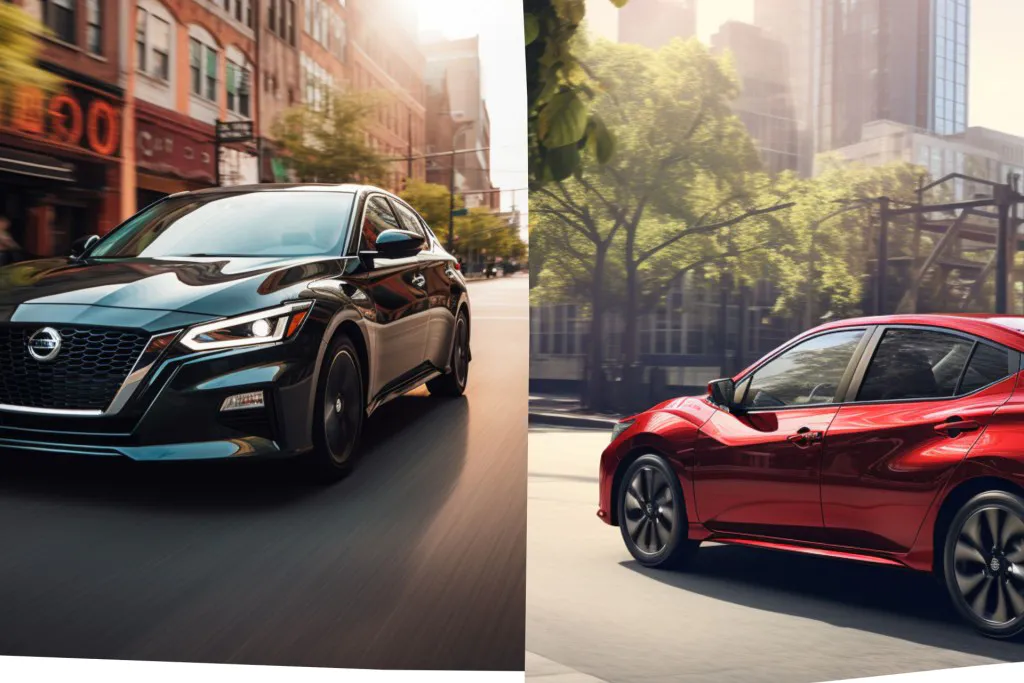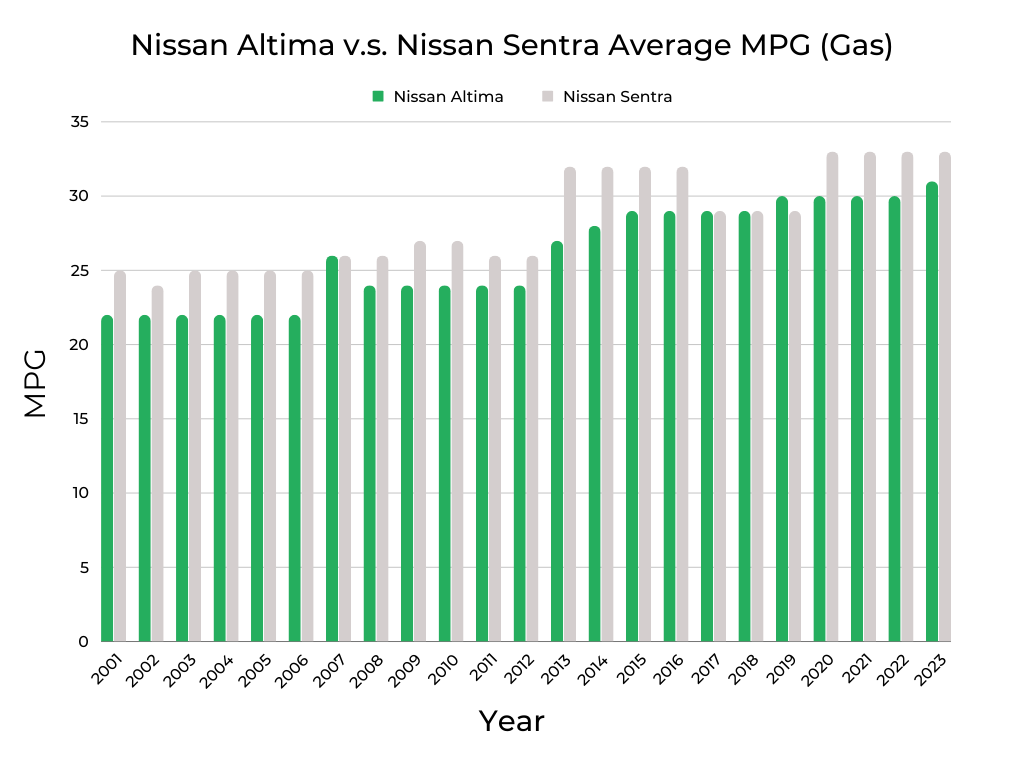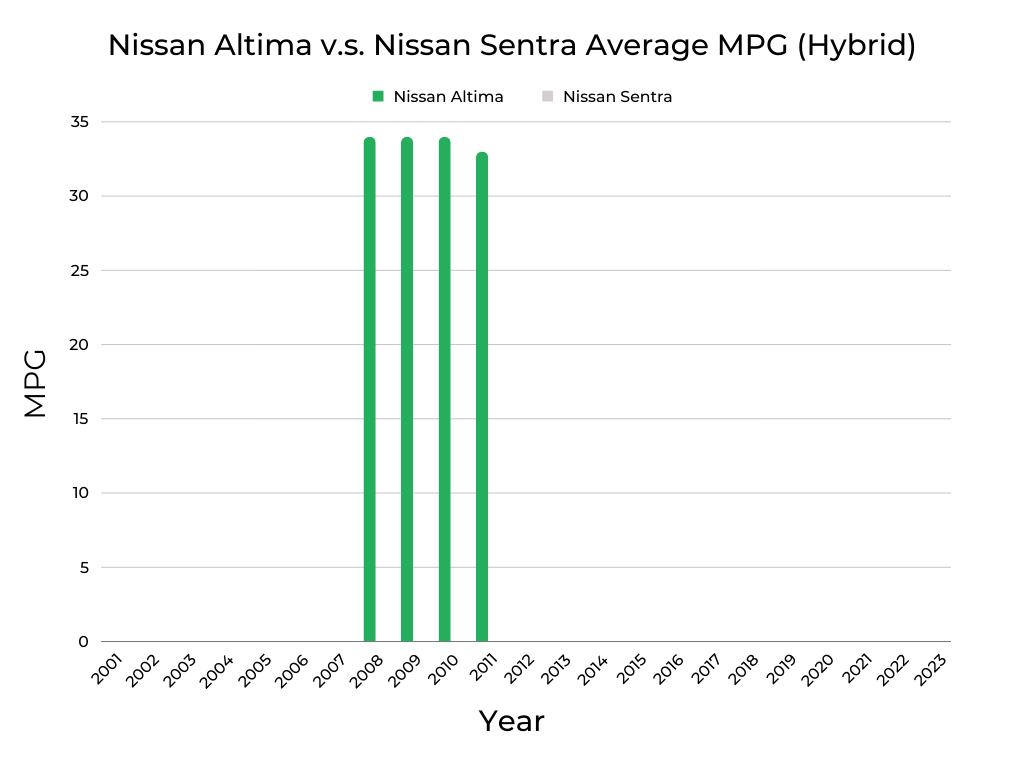Nissan is the rare automaker these days that continues to offer a deep roster of sedans amongst the sea of SUVs. Two of them, the compact Sentra and midsize Altima have been on sale for a combined 72 years. That sort of staying power is proof of how popular these Nissans have been and continue to be.
So, to help shoppers decide which of these Nissans is best for them, we’ve put together a comprehensive comparison between brand-new 2023 model years and used models going back to 2001.
| Income Bracket | Monthly Financing Cost Range | Cash Purchase Price Range | Nissan Altima Years | Nissan Sentra Years | Best Model Year: | Why? |
| < $5k | $42 – $83 | $1,500-$3,000 | N/A | N/A | N/A | Only Altimas and Sentras from our list of worst model years fit this price range |
| $5k-$10k | $83 – $125 | $3,000-$4,500 | N/A | 2009, 2010 | 2009 Sentra | The Altima doesn’t offer a “best of” model year for this price range |
| $10k-$15k | $125 – $187 | $4,500-$6,750 | 2011-2014 | 2012, 2014, 2015 | 2013 Altima | Altima matches Sentra on reliability but has a better safety score |
| $15k-$25k | $187 – $312 | $6,750-$11,250 | 2015, 2016 | 2016, 2017 | 2016 Sentra | Sentra meets the Altima on reliability but offers better fuel economy |
| $25k-$35k | $312 – $437 | $11,250-$15,750 | 2017, 2018 | 2018 | 2018 Sentra | Better FIXD Reliability Score |
| $35k-$50k | $437 – $625 | $15,750-$22,500 | 2019, 2020 | 2019, 2020, 2021 | 2020 Altima | Perfect FIXD Reliability Score |
| $50k-$74k | $625 – $925 | $22,500-$33,300 | 2021 | N/A | 2021 Altima | It’s the only option from our “best of” rankings in this price bracket |
See the methodology for the table above.
Though the Nissan Altima is in the midsize sedan segment and the Nissan Sentra is considered a compact, these two Nissans have historically had a lot of overlap in the powertrain and amenities department. You’ll generally find more room in an Altima, but the Sentra’s smaller footprint typically means it’s more efficient.
To find out which Nissan is the best bet from a brand-new and used perspective, we’ve put together this Nissan Altima vs. Nissan Sentra comparison.
It takes into account objective and subjective reliability data, safety scores from the National Highway Traffic Safety Administration (NHTSA), resale values per Kelley Blue Book (KBB), fuel economy figures published on FuelEconomy.gov, and annual upkeep costs per owner surveys.
It also factors in data from the above table, which offers a quick view of what to expect based on your budget. Each row notes the best model year Nissan Altima and best model year Nissan Sentra according to income range, monthly financing costs, and purchase price per KBB.
For a model year to make it into a given row, it needs to have already been selected as a “best of” according to our deep-dive Best and Worst Model Years series, which covers both the Altima and Sentra. From there, we pick a winner for each row with a quick reason as to why.
We’ll go deeper into this reasoning below, but the goal here is to inform would-be buyers on which Nissan is the better buy, whether that’s a new 2023 model or a used version going back to 2001.
If you’re already in the market, check out our used car buying checklist before responding to any “For Sale” ads. And if you’re looking to cross-shop the Nissan Altima and Nissan Sentra, the following list of articles provides several relevant comparisons and model-specific analyses.
For midsize sedan shoppers:
- Nissan Altima vs. Toyota Corolla
- Best & Worst Model Years of the Toyota Camry
- Best & Worst Model Years of the Honda Accord
- Best & Worst Model Years of the Ford Fusion
- Best & Worst Model Years of the Chevrolet Malibu
And for the compact crowd:
- Best & Worst Model Years of the Toyota Corolla
- Best & Worst Model Years of the Honda Civic
- Best & Worst Model Years of the Ford Focus
- Best & Worst Model Years of the Chevrolet Cruze
Price History Comparison | Nissan Altima vs. Nissan Sentra
Average Market Value – Based on Owners’ Self-Reported Mileages | Nissan Altima vs. Nissan Sentra
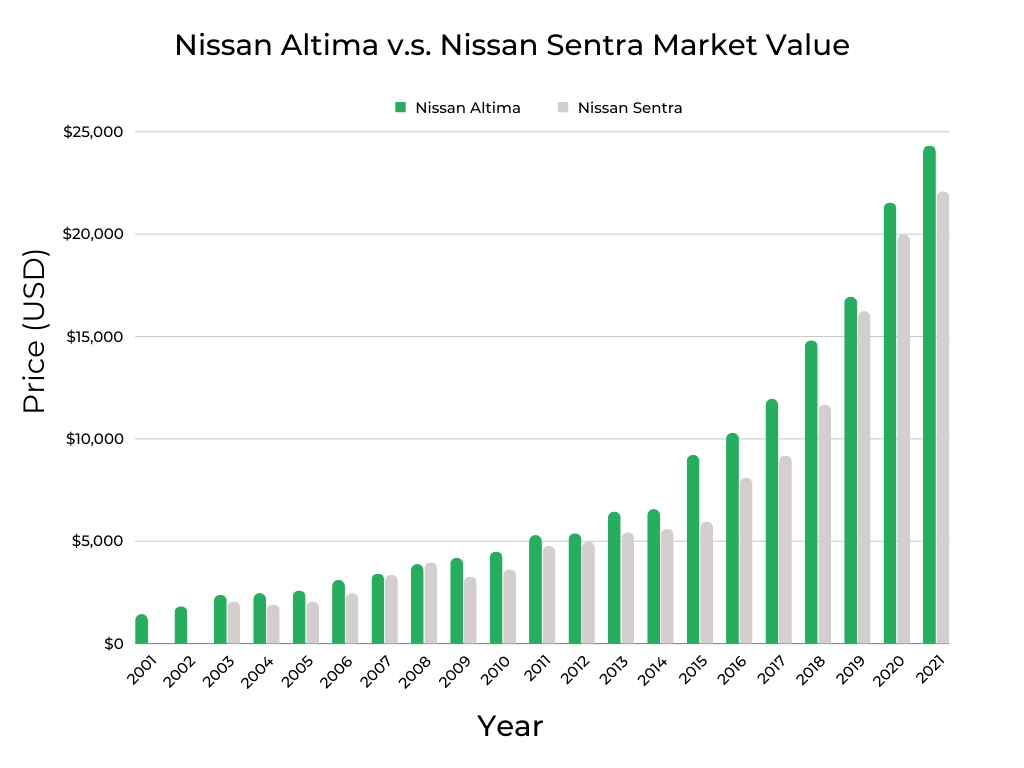
The chart above plots the market value over 20 years of the Nissan Altima and Sentra. It’s a quick way to get a sense of which model years are within your budget. As is typically the case, older models cost less as they tend to have higher mileage.
On that note, the type of mileage is important as a vehicle with high miles that were accrued during long highway drives is not necessarily worse than one with low miles that was primarily driven around town in stop-and-go traffic. So do your homework with previous owners before making any purchases.
As it relates to the Altima and Sentra specifically, this chart illustrates how the Altima will cost you more than the Sentra every year for the past 20 years, though 2007 and 2008 are fairly close together. This is to be expected as the Altima has always been the bigger, more premium vehicle than the smaller Sentra.
The gap in market price was relatively dramatic in 2015, but there is no clear reason as to why. These model-year Altimas average just under 100,000 miles per owner surveys versus about 113,000 miles on the 2015 Sentra. And both cars get a thumbs up in the best model years of the Altima and best model years of the Sentra articles.
For people looking to buy, this means that with all else equal – reliability, safety, etc. – the Sentra will cost you less if you’re okay with the smaller size.
Depreciation vs Maintenance Expenses
There’s no denying the appeal of a new car, all shiny and fresh with a big 0 on the odometer. But, when you account for depreciation, savvy buyers know that used cars have the purchase advantage. That’s because a new car drops in value by 10 to 15% after one year of ownership and up to 50% in just 5 years.
Older vehicles naturally have more wear and tear, which can result in higher repair bills. But when you look at the depreciation data for the Nissan Altima and Nissan Sentra, you may find yourself wondering if there’s a way to dodge depreciation AND the likelihood of expensive repairs.
This is where the above charts – that plot depreciation against residual value – come into play. The black box on each graph highlights the model years for the Altima and Sentra that sit in a sweet spot of these two metrics.
It’s an area that takes as much advantage of depreciation as possible while aiming for relatively low upkeep costs per mile of ownership. For the Nissan Altima, that sweet spot is between 2007 and 2014, a range that has residual values no greater than 15% and maintenance costs of between 5 and 8 cents per mile.
For those in the market, be aware that the 2010, 2012, 2013, and 2014 Nissan Altimas are both in the sweet spot above and on the thumbs-up side of our best & worst model year rankings.
Looking at the Sentra chart on the right, we can see this sweet spot ranges between 2004 and 2012. Of those years, 2009, 2010, and 2012 are all “best of” picks from our best & worst Sentra model year rankings.
These Sentras have average maintenance costs per mile in the 2 ½ to 10 cents range, which is both slightly lower and higher than the Altima. In keeping with the aforementioned market value graph, the Sentra will have a lower price tag in this sweet spot range as the residual value doesn’t get past 12%.
Reliability Comparison | Nissan Altima vs. Nissan Sentra
The chart above, on the left, compares objective FIXD Reliability Scores for the Altima and Sentra between 2001 and 2021. As you can see, there’s not a clear-cut answer to whether one of these Nissans is more reliable than the other. They have identical scores for 6 of those 21 years.
Of the years that the Altima scores higher than the Sentra, only 2013, 2019, and 2020 land on the right side of our best and worst Altima model years ranking. And for the Sentra, only 2009 and 2018 are years it scored higher in this metric versus the Altima AND got a thumbs up on the best and worst Sentra model years ranking.
So, don’t assume that just because one is objectively more reliable than the other for a given year, it is a better vehicle. Those best and worst model year rankings take into account other factors like safety ratings and maintenance costs, so it’s worth spending some time on research before making a purchase decision.
On the other hand, in 2019 and 2020, both the Altima and Sentra earned a thumbs up according to these rankings. But, as you can see on the chart, the Altima has significantly higher FIXD Reliability Scores in those years.
2016 was another year that both of these Nissans were recommended according to our rankings, but this time it’s the Sentra that handily bests the Altima on the objective reliability comparison.
You can see how owners rank their Nissan Altimas and Sentras with the chart above on the right. Based on survey responses, this subjective data set illustrates that for the most part, owners are happy with their Nissan sedans.
However, the 2005 through 2007 range is notably lower than the rest of the model years. Turns out, all 3 of these model years – for both cars – land on the wrong side of our best and worst model year rankings, so are best avoided.
Longevity Comparison | Nissan Altima vs. Nissan Sentra
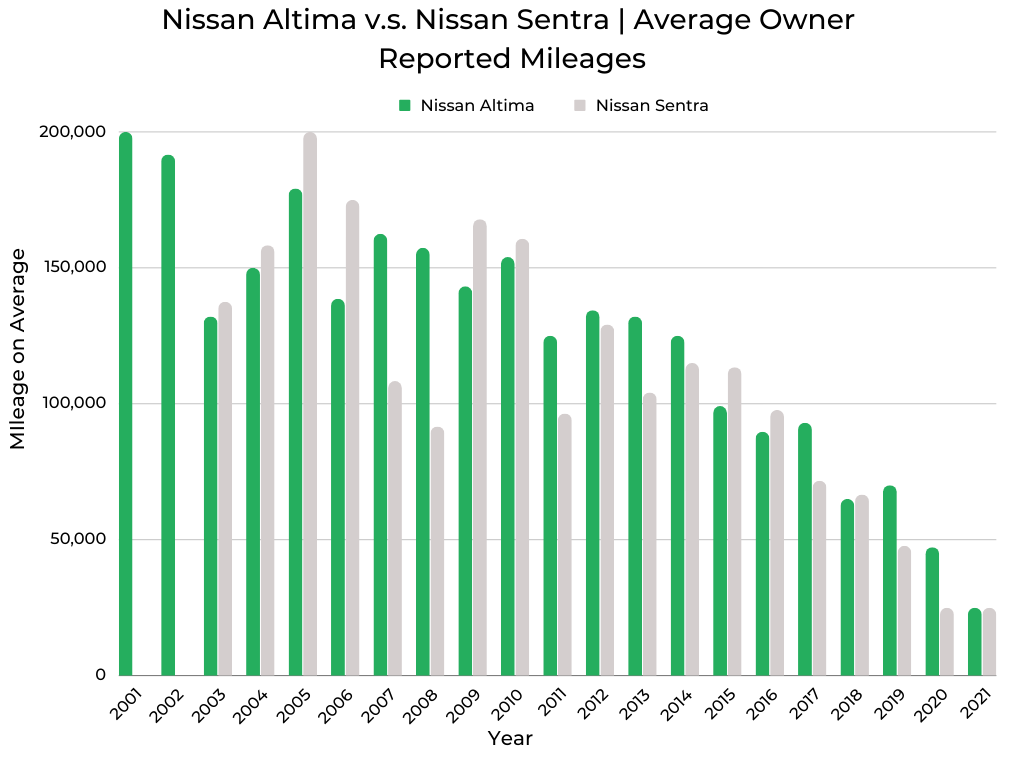
Following suit with the reliability discussion from above is that neither Nissan does a “better” job of racking up miles. As you can see on this chart of owner-reported mileage, it’s about evenly split for which car has more miles for a given model year.
This is particularly true from 100,000 miles and beyond, which suggests there’s no wrong answer for which high-mileage Nissan has better longevity. We can’t compare the 2001 and 2002 model years as we do not have enough Sentra data for this range.
But, it is clear that between 2003 and 2015, a Nissan Altima or Sentra with 100,000 miles or more on the clock should not be cause for concern as both cars generally meet or exceed this milestone.
This is a useful piece of information when it comes to purchasing as you can get an idea of what kind of mileage to expect from the model year you’re looking at. But, be sure to weigh this factor against other important information like maintenance costs, safety scores, and reliability.
Our handy best and worst model year rankings series covers this very information for both the Nissan Altima and Nissan Sentra!
2023 Nissan Altima vs. Nissan Sentra | A Guide to Trim Levels & Optional Features
Trim Levels: Starting Prices
So, we’ve looked at various options when it comes to a used Nissan Altima and Nissan Sentra, but if it’s a brand-new model you’re after, you’ve come to the right spot. For starters, we’ll look at price points using the table below.
As you can see, the Altima has a starting price of some $6,500 higher than the Sentra and tops out nearly $14,000 higher. This helps to explain why the market value comparison from before shows the Altima commanding a higher price than the Sentra almost every year.
We’ll get into the details behind why the Altima is more expensive than the Sentra, but for starters, it’s a physically larger vehicle with more cabin space. As well, both come standard with a four-cylinder engine, but in the Altima, it makes quite a bit more power.
Finally, the top-spec SR VC-Turbo Altima is, as you may have surmised, turbocharged and more potent by far than any Sentra. Fortunately, aside from that variant, the Altima and Sentra follow similar trim line naming conventions, which makes for an easier comparison.
| 2023 Nissan Altima Model | Starting Price |
| S | $26,725 |
| SV | $27,525 |
| SR | $28,925 |
| SL | $33,425 |
| SR VC-Turbo | $36,425 |
| 2023 Nissan Sentra Model | Starting Price |
| S | $20,200 |
| SV | $21,420 |
| SR | $23,090 |
| SR Midnight Edition | $23,785 |
2023 | Nissan Altima vs. Nissan Sentra | Specifications | Safety, Interior and Exterior Features
For an in-depth comparison of the 2023 Nissan Altima and Nissan Sentra, we need to get a full understanding of the various specifications of each car.
Vehicle Class & Body Style:
Both of these Nissans are 4-door sedans, but per the U.S. Environmental Protection Agency, the Altima is in the mid-size segment and the Sentra is of the compact variety. These classifications are based on passenger volume and cargo space but don’t tell the whole story.
For example, the Nissan Altima only offers an extra half-inch of rear legroom over the Sentra and one extra cubic foot space in the trunk. However, overall passenger volume is more than 4 cubic feet larger in the Altima. We’ll look at this more closely below, but it’s worth understanding these less obvious differences if you’re in the market.
| 2023 Nissan Altima | 2023 Nissan Sentra | |
| Class | Mid-Size Sedan | Compact Sedan |
| 4-Door Sedan | S, SV, SR, SR VC-Turbo, SL |
S, SV, SR, SR Midnight Edition |
Powertrain:
Engine Options & Specifications:
Unlike the interior space comparison, the powertrains on these two Nissans could not be more different. Across the 2023 Sentra lineup, a 2.0L inline-4 with 149 horsepower is standard. Altimas come with a 2.5L unit good for 188 horses and unlike the Sentra, the Altima offers AWD.
For those interested in performance, only the Altima can deliver with its optional turbocharged 2.0L powertrain rated for 248 hp. It can do the 0-60 mph sprint nearly 3 seconds faster than a Sentra, which is significant for this metric.
Interestingly, the Altima doesn’t give up too much in the fuel efficiency department versus the Sentra when comparing FWD models. And with the Altima, a larger gas tank translates to nearly an extra 100 miles of driving range.
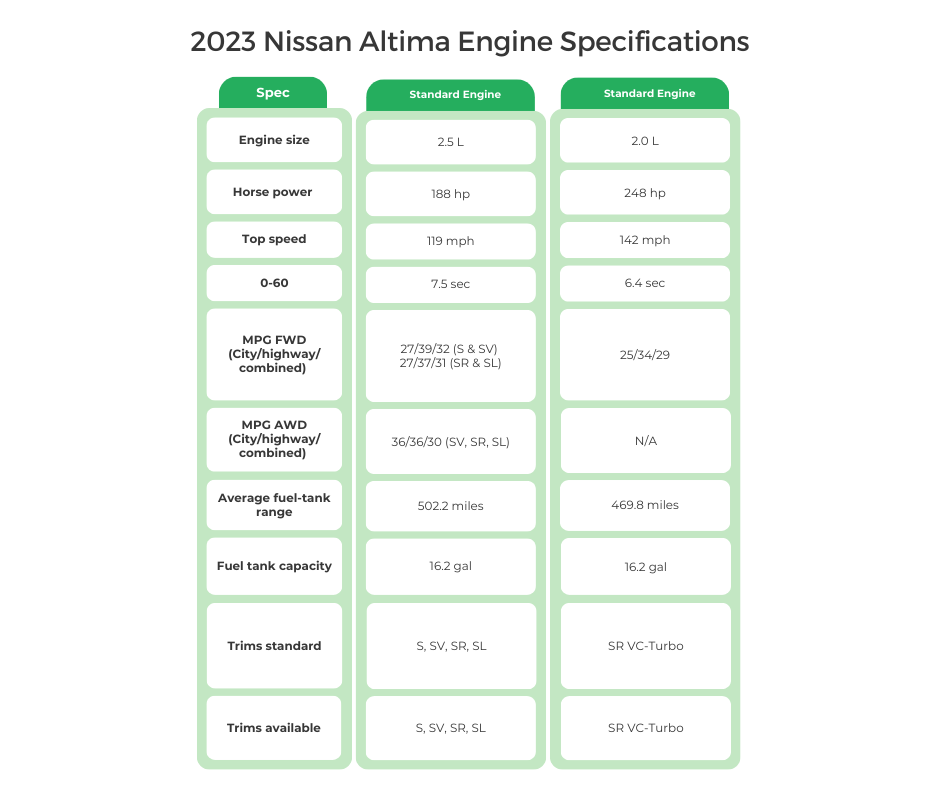
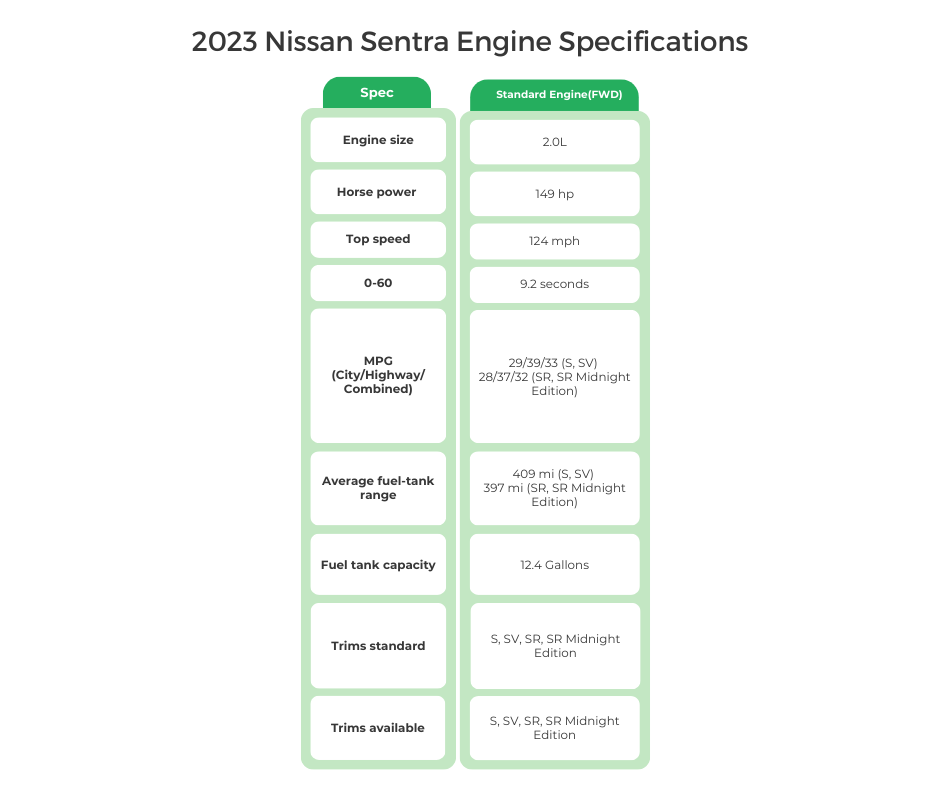
Transmission Options & Specifications:
Nissan makes the transmission comparison between its 2023 Altima and Sentra simple by fitting both with the continuously variable variety. If your eyes glaze over at the mention of transmission, just rest easy knowing both of these Nissans are on equal footing for this aspect.
But for the rare reader that perks up when it’s time to talk transmissions, be sure to check out the CVT tech talk section below!
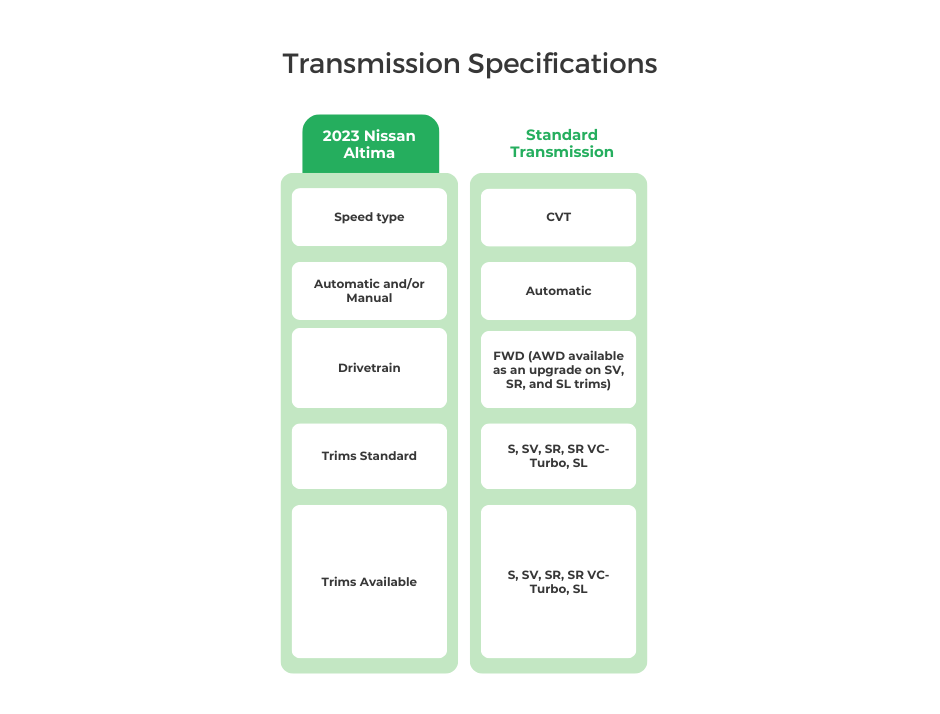
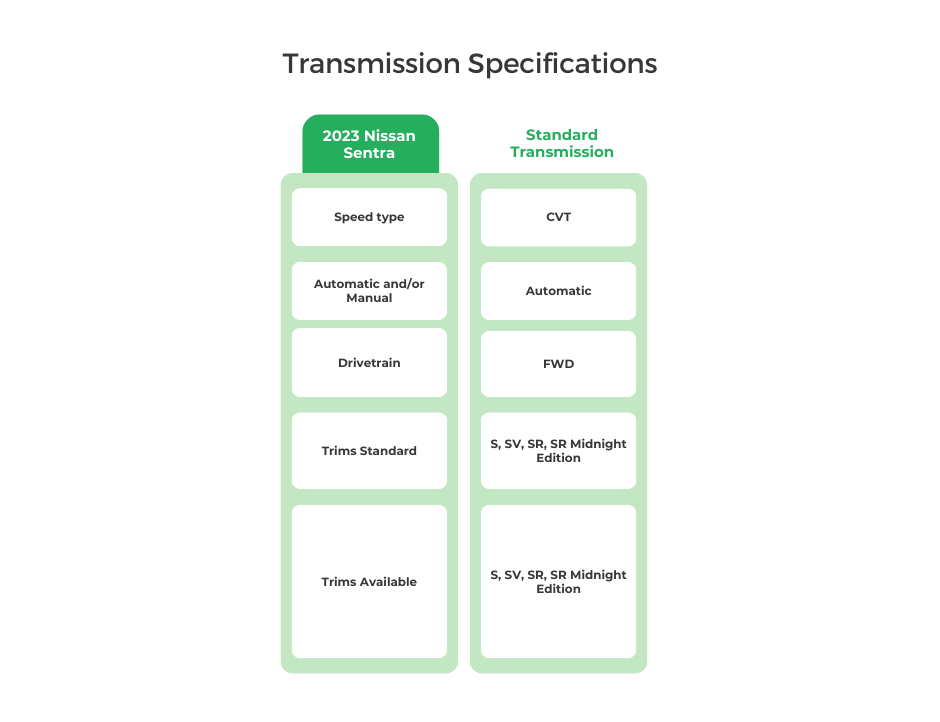
TECH TALK: CVTs
A continuously variable transmission (CVT) does not use gears like a typical automatic transmission. Instead, it has two pulleys connected by a belt. One pulley connects to the engine, and the other connects to the wheels. The belt transfers the power between the pulleys. This setup allows the pulleys to continuously change positions as needed. The CVT automatically adjusts the pulleys as required, providing smooth and efficient power delivery.
An electronic continuously variable transmission (eCVT) uses electronic controls and electric motors to vary gear ratios instead of a belt and pulley system. Unlike a regular CVT, an eCVT has no physical pulleys or belts—the gear ratio is adjusted seamlessly by controlling the speeds of electric motors and generators. This electronic control allows faster, smoother gear ratio changes compared to a traditional CVT. An eCVT also provides more flexibility, needing less space and having fewer moving parts.
Wheel Drive:
Both the 2023 Nissan Altima and Sentra are FWD-based cars, but only the Altima offers AWD. It’ll run you an extra $1,500 and is only available on the SV, SR, and SL trim lines, but for those in search of more traction when the road gets slick, you may find the Altima more suitable than the Sentra
| 2023 Nissan Altima Wheel Drive | FWD | AWD | RWD |
| S | S | ||
| SV | S | U | |
| SR | S | U | |
| SR VC-Turbo | S | ||
| SL | S | U |
| 2023 Nissan Sentra Wheel Drive | FWD | AWD | RWD |
| S | S | ||
| SV | S | ||
| SR | S | ||
| SR Midnight Edition | S |
U = Available in upgrade
Safety:
NHTSA Safety Ratings:
Given both of these 2023 Nissans are family cars first and foremost according to FIXD owner survey responses, it’s a good thing they both earn a 5-star overall safety rating from the NHTSA. They both have identical scores for the other crash-testing protocols as well, so no need to choose one over the other for safety reasons.
Specifically, the 2023 Nissan Altima and Sentra earn a 5-star overall rating, a 4-star frontal crash rating, 5 stars for the side crash test, and a 5-star rollover rating.
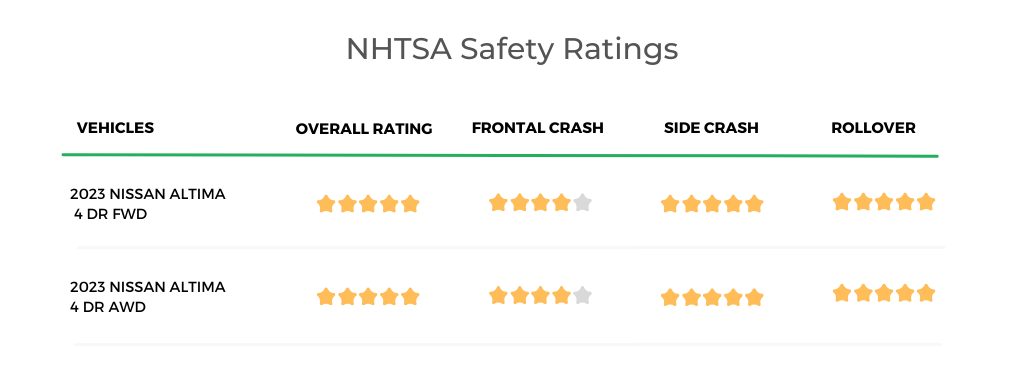

IIHS Awards:
Things are a little less favorable from a safety perspective on the 2023 Altima and Sentra per the Insurance Institute for Highway Safety (IIHS).
Like the NHTSA, the IIHS performs crash testing on vehicles, but it makes the testing more comprehensive by adding protocols for the evaluation of roof strength, head restraints & seats, headlights, and advanced safety nets like automatic emergency braking.
Instead of using stars to rank safety, the IIHS awards ratings of Good (the best), Acceptable, Marginal, and Poor (the worst). For vehicles with exceptionally high testing performance, like our comparison subjects, the IIHS gives out Top Safety Pick (TSP) and TSP+ awards.
To earn the plus sign, a vehicle must have ratings of Good for all crash tests versus the TSP rating that allows for an Acceptable score in the side crash test.
The reason things are less favorable here is that those awards were based on initial tests per the IIHS. With the updated tests, we see that the 2023 Altima received a Good rating on all tests aside from a Moderate rating for the moderate front overlap test and a Poor rating in the side crash test.
Likewise, last year’s Sentra award was based on initial test results, but updated testing led to a Poor rating for the moderate overlap protocol and Good ratings for the rest of the crash testing.
| IIHS Award | Tested Vehicle | ||
| 2023 Nissan Altima | Midsize Car/ 4-Door Sedan |
2022 TOP SAFETY PICK + |
2019 & 2023 Nissan Altima 2.5 S 4-door |
| 2022 Nissan Altima 2.5 SV 4-door |
|||
| 2023 Nissan Sentra | Small Car/ 4-Door Sedan |
2022 TOP SAFETY PICK |
2020 Nissan Sentra SV 4-Door |
Airbags & Head Restraints:
Given their prevalence, it’s easy to assume any new car is filled with the latest airbag technology. But, considering how effective these safety systems are in protecting passengers during a collision, it’s important to spend a few minutes learning the specifics of the vehicle you’re looking at.
Fortunately, in the case of the 2023 Altima and Sentra, there are no differences, so you can rest easy with either choice. Both Nissans come with 8 standard airbags including side impact and curtain airbags for both rows.
Conversely, neither the Altima nor the Sentra offer overhead airbags or active head restraints. Overhead airbags are a relatively new addition to the industry that offer additional head protection, while active head restraints are designed to reduce whiplash in rear-end collisions and are more common on high-end vehicles.
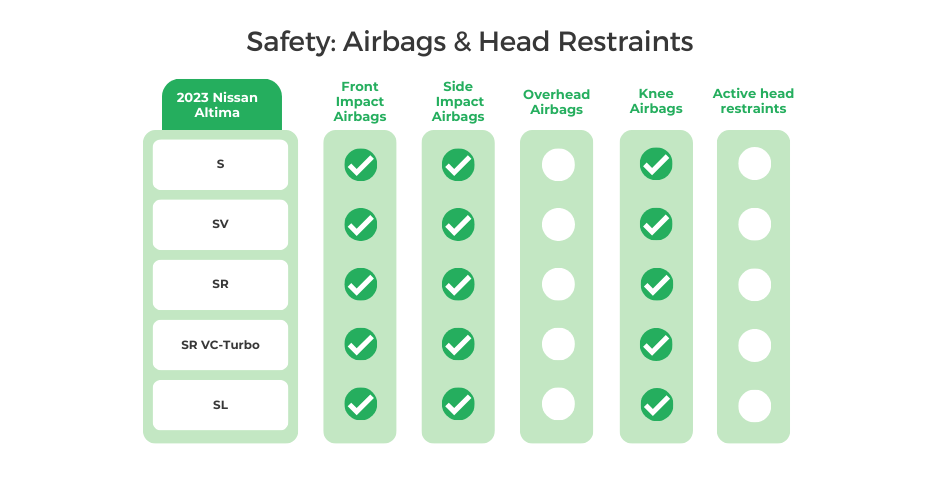
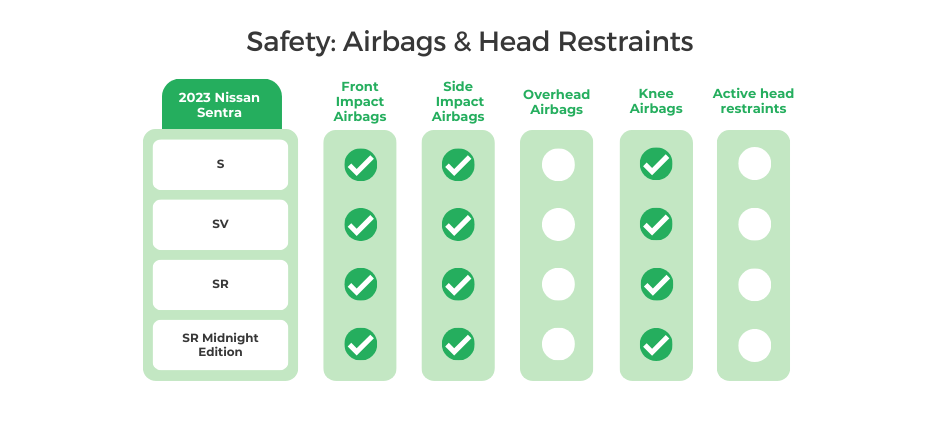
Semi-Autonomous Driving:
For those looking to see what semi-autonomous driving is all about, only the 2023 Altima offers it, the Sentra does not. An optional feature within the automaker’s Safety Shield 360 bundle of advanced driver-assistance systems (ADAS), Nissan dubs it “ProPILOT Assist”.
The same is true of technology that can take control of the steering to make sure you stay in your lane as Intelligent Lane Intervention is another Altima-only system. Both the Altima and Sentra come with traditional cruise control and the option for the adaptive version that can manage speed and distance for you.
Automatic parking, which is more common on higher-end vehicles, is not offered on either of these Nissans, but both come standard with a full complement of modern stopping tech like automated emergency braking, electronic brake-force distribution, and rear automatic braking.
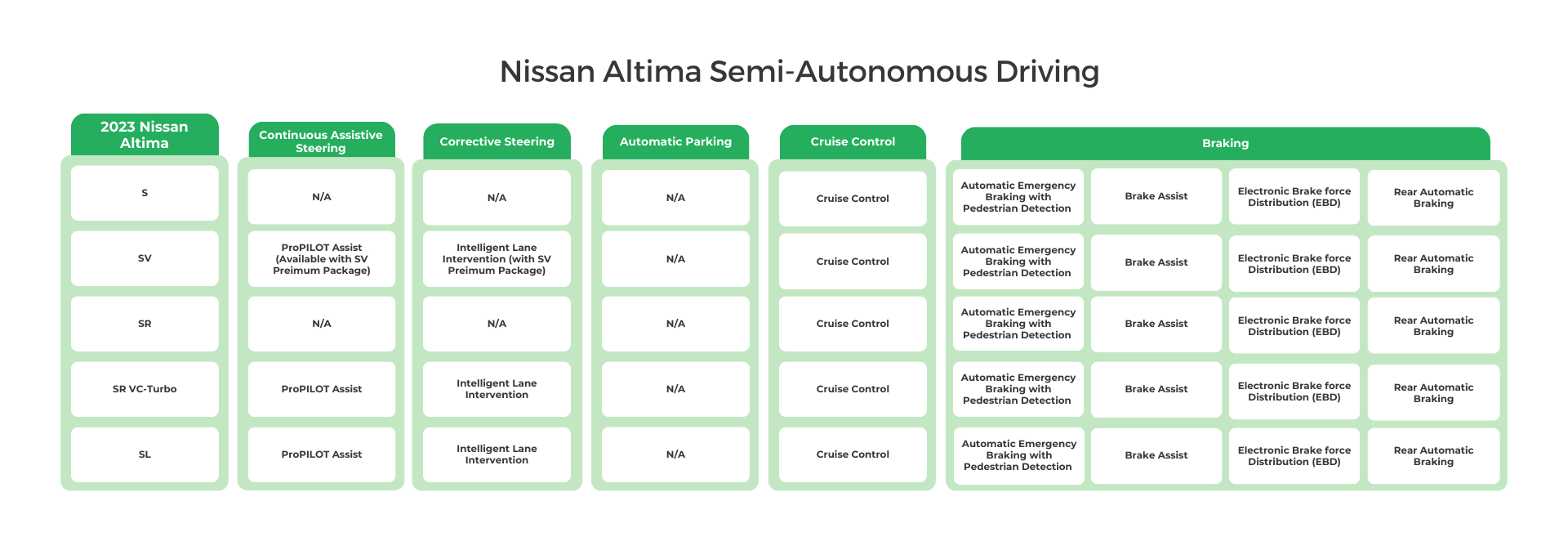

Driver Warning Systems & Telematics:
Driver warning systems and telematics go hand-in-hand with the Safety Shield 360 suite of ADAS and in the case of the 2023 Altima and Sentra, there are several systems standard across the respective lineups. That includes forward collision warning with pedestrian detection, blind-spot monitoring, rear cross-traffic alert, and a driver attention monitor.
You won’t find intersection turn assistance on either of these Nissans, but both feature lane-departure warnings with the ability to correct your steering should you venture out of that lane. Traffic sign recognition, which displays relevant sign details on your instrument panel, is widely available on the 2023 Altima, but not on the Sentra.
Nissan Connect, the automaker’s telematics system, is only included in Altima SL and Sentra SR models. This subscription-based service allows you to control certain vehicle functions like door locks, engine start, and HVAC via an app.


Road Visibility Features:
LED headlights have become increasingly common on new cars as they provide sharper illumination than the old-school halogen bulbs. However, only the Altima has LED headlights as standard equipment. You’ll need at least an SR trim on the Sentra for this feature.
Across both Nissan vehicles, automatic high beams are included. This handy system turns the high beams on and off for you, which is mostly a benefit to oncoming drivers. The same is true of a backup camera, though this feature became federally mandated in 2018.
Adaptive headlights that swivel in concert with steering inputs, rain-sensing wipers that manage wiper speed for you, and a head-up display that projects pertinent vehicle details onto the windshield are all still relatively premium systems. As such, none are available on these mainstream Nissans.

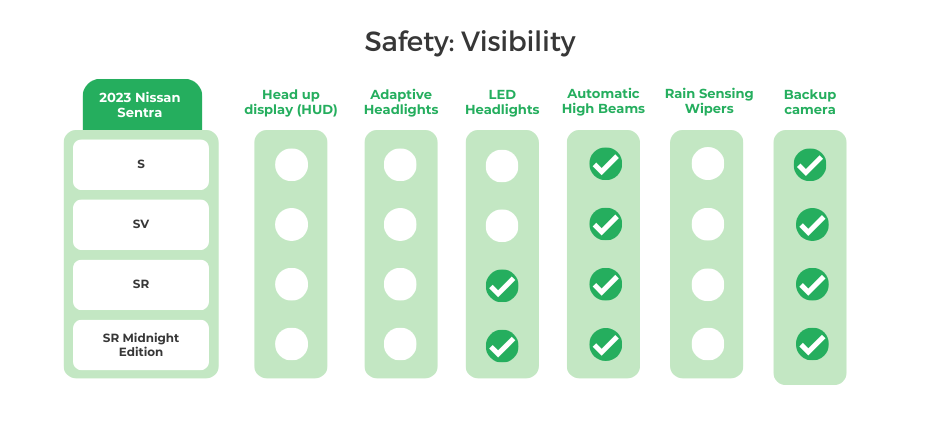
Interior:
Interior Features:
Apple CarPlay and Android Auto have become increasingly common features on new cars these days as they helpfully mirror your smartphone screen onto your car infotainment screen. Across the 2023 Altima and Sentra lineup, both systems are standard.
Heated seats, on the other hand, remain a coveted but not guaranteed creature comfort. The top two Altima models come with heated front seats or they can be added to the SV and SR. With the Sentra, this feature costs extra on any model, but neither car offers heated seats on the respective base model.
Subscription-based heated seats fall under the burgeoning “Features On Demand” category, which most people are either unfamiliar with, skeptical of, or both. However, McKinsey says this new automotive industry segment is set to take off, so you can expect to see more FOD-related efforts in the future.

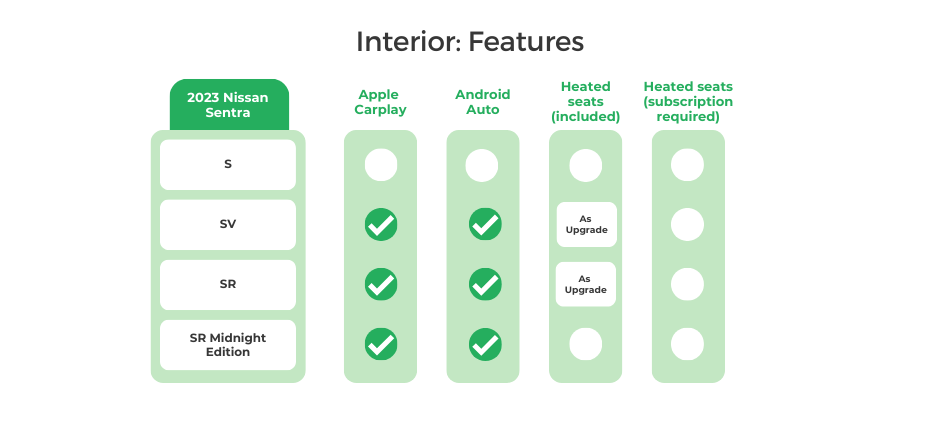
Interior Dimensions:
We touched on this earlier, but it bears repeating – a car is more than its classification category. Though the 2023 Altima is considered a midsize sedan and the 2023 Sentra a compact, both comfortably seat 4 people.
Up front, the Sentra has a smidge more legroom and nearly an inch more headroom. The Altima only has half an inch more rear legroom and the rear headroom measurements are identical. So, how does the Altima end up in a different category?
It has between 1 and 2 ½ more inches of shoulder and hip room – for both rows of seating – than the Sentra. As well, the Altima’s trunk offers an additional cubic foot of storage volume. Altogether, there are an extra 4.6 cubic feet of passenger volume inside the Altima than the Sentra.
But, depending on your needs, legroom might be more important than how much width you have in the back seat, especially if each car comfortably seats only 4 passengers. In which case, the Sentra offers similar stretch-out space for less money.

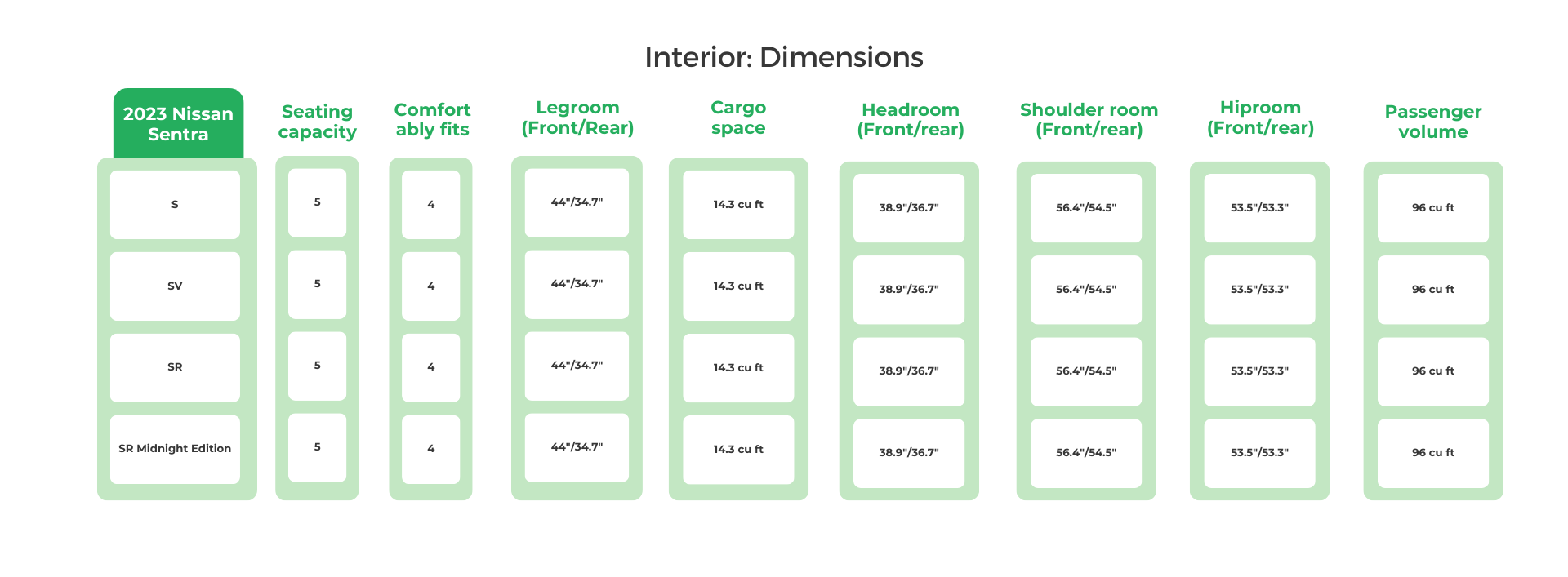
Exterior:
Exterior Features:
Showing their economy car roots, both the 2023 Nissan and Altima can still be had with 16” steel wheels and hubcaps, albeit only on the base models. From there, the Sentra offers 17” and 18” alloys, but only the Altima allows for size 19s.
And boy do those SR VC-Turbo rims look killer, but be aware that with style of this size comes a potential penalty in the ride quality department and a guaranteed steeper replacement cost.
As for overall exterior looks, both of these Nissans can be painted in the popular shades of gray AKA white, silver, and black. While the added spice of a red finish is offered on the Altima and Sentra, only the Sentra can be had with a two-tone scheme including the particularly loud Monarch Orange and Black design.
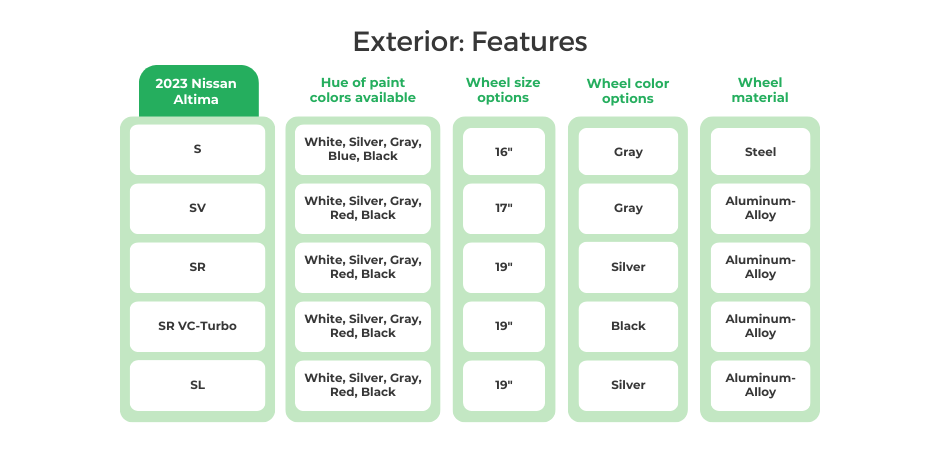
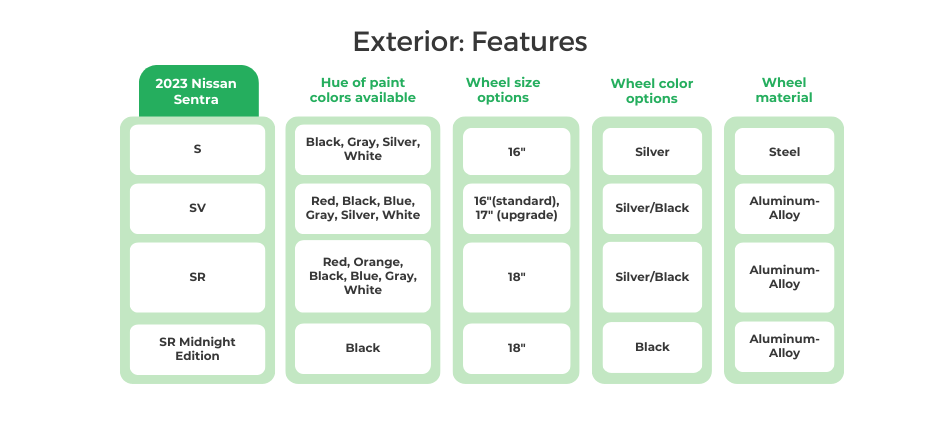
Exterior Dimensions:
Considering the 2023 Altima is nearly 10 inches longer than its Sentra stablemate with about 5 extra inches between the wheels, the similarities in legroom, as noted above, are all the more surprising. Of course, it does have a larger trunk and the added width aligns with the Altima’s greater shoulder and hip room.
What’s not surprising is that the Altima is heavier across the board by 200 to 300 pounds than the Sentra. Nissan has managed to keep fuel economy between these two sedans similar, so curb weight shouldn’t have much impact on which car is better for a would-be buyer.
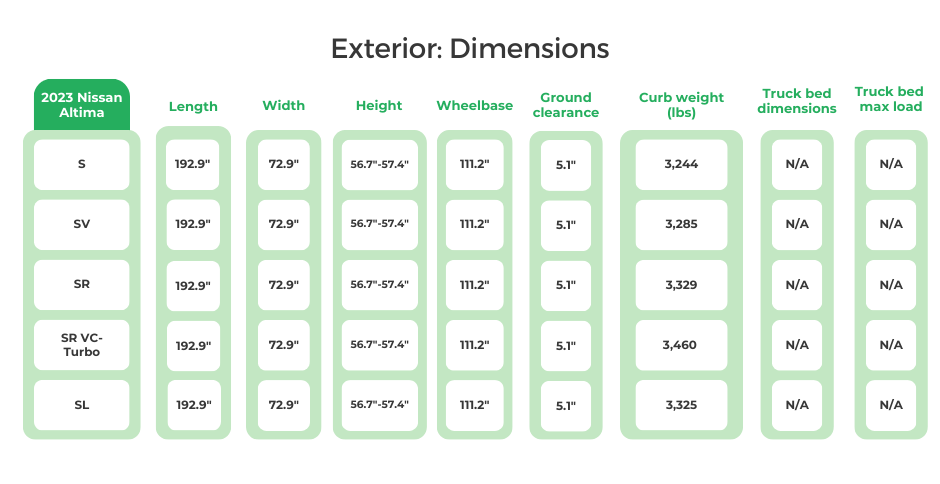
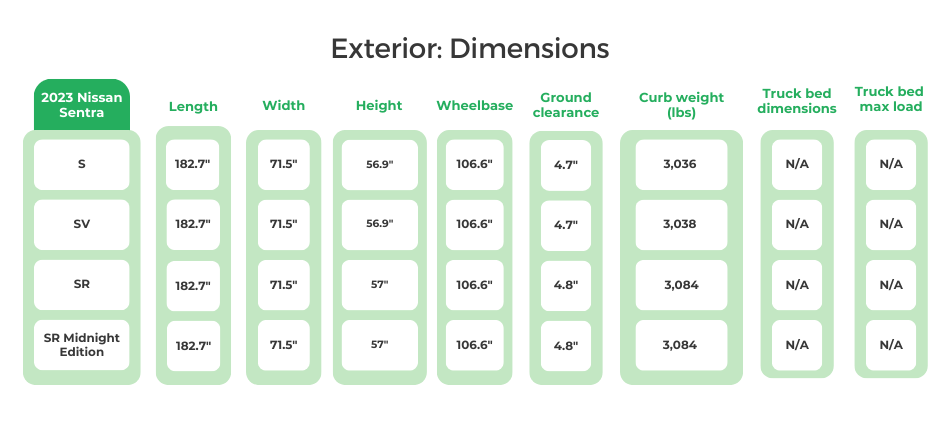
Warranty:
Naturally, the warranty terms for the 2023 Nissan Altima and 2023 Sentra are identical. Meeting the mainstream average coverage, it offers a 3-year/36,000-mile basic term and a 5-year/60,000-mile powertrain term.
Something Nissan doesn’t offer is complimentary maintenance. If you’re cross-shopping these cars against the likes of a Toyota Camry, Honda Accord, Toyota Corolla, or Honda Civic, keep in mind that both of those automakers include 2 years of complimentary factory-scheduled service.
| 2023 Nissan Altima Factory Warranty Coverage: |
2023 Nissan Sentra Factory Warranty Coverage: |
|
| Basic warranty: | 36 months/36,000 miles | 36 months/36,000 miles |
| Powertrain warranty: | 60 months/60,000 miles | 60 months/60,000 miles |
| Corrosion perforation warranty: | 60 months/unlimited miles | 60 months/unlimited miles |
| Air conditioning warranty: | 12 months/unlimited miles | 12 months/unlimited miles |
| Battery warranty: | 24 months | 24 months |
| Emissions warranty: | Federal: 36 month/36,000 miles (defect), 24 months/24,000 miles (performance) California: 36 months/50,000 miles (defect), 36 months/50,000 miles (performance) |
Federal: 36 month/36,000 miles (defect), 24 months/24,000 miles (performance) California: 36 months/50,000 miles (defect), 36 months/50,000 miles (performance) |
| Roadside assistance coverage: | 36 months/36,000 miles | 36 months/36,000 miles |
| Total unique recalls: | 0 | 0 |
Driver Experience | A Summary of The Top 10 Nissan Altima vs. Nissan Sentra Reddit Posts:
For an unfiltered perspective on the Nissan Altima and Sentra, we kindly direct you to the What Car Should I Buy Reddit. Here, you can “enjoy” feedback from owners of both cars – positive and negative. After strolling through this colorful online community, we found some common threads from folks comparing these two Nissans.
For one thing, most people were curious if the Altima was worth the “extra $7,000” over a Sentra, which is a valid question.
In favor of spending more were comments about the Altima having a bigger engine, a nicer interior, more room, and a better ride. The Altima has more powerful engine options and while saying it has a nicer interior is an opinion, Nissan intends the Altima to be a more premium option over the Sentra.
But on the subject of more room, we know from reviewing the specs above that the 2023 Altima and Sentra are close on paper, which one user, in particular, backed up with the comment, “ I would argue that the interior size of my Sentra is comparable to that of my Altima…”
This user also noted, “It seems as though many compact cars have less trunk space rather than a less-roomy interior”, which in both instances provides real-world insight into what seems to be true on paper.
As for the Altima having a better ride, there was one thread pointing out that the Sentra’s ride isn’t as nice as the Altima’s because of its torsion beam rear suspension versus the multi-link rear on the Altima. This is true of the previous generation Sentra, but as of 2020, the latest Sentra series also rides on a multi-link rear suspension.
Who Should Buy These Cars: The Legacy of The Nissan Altima & Nissan Sentra
| Frequent Use Categories: | Nissan Altima | How Useful? (Out of 5 Stars) |
Nissan Sentra | How Useful? (Out of 5 Stars) |
| Family Vehicle | * * * * * | * * * * * |
| Lots of Driving (travel/long commute) | * * * * * | * * * * * |
| Hauling/Towing | * | * |
| Office on Wheels | * | * |
| Sport/Fast Driving | * | * |
| Luxurious Driving | * | * |
| Outdoor/Off-Road | * | * |
Given the high mileage we saw above, it’s no surprise that “Lots of Driving” is one of the most frequently cited uses of the Nissan Altima and Sentra according to owner survey responses. Family vehicle also receives 5 stars here, which aligns with the high safety marks both Nissans have earned.
Though the other categories largely don’t fit the missions of either Nissan, over time there have been variants like the 5th-gen Sentra SE-R Spec V and current Altima SR VC-Turbo that would fit the “Sport/Fast Driving” mission.
Year-by-Year Comparison | Nissan Altima vs. Nissan Sentra
Best & Worst Years | Nissan Altima vs. Nissan Sentra | 2001-2024

For a quick look at the best model years (green) and worst model years (red) of both the Nissan Altima and Nissan Sentra, take a look at the timeline graphic above. The yellow sections are years that we do not have enough data to make an informed decision.
Looking at the Altima timeline, it’s worth noting that 2010, 2012, 2013, and 2014 hit both the “best of” criteria and fall within the sweet spot of depreciation versus maintenance cost per mile range discussed above. For the Sentra, it’s the 2009, 2010, and 2012 model years that fit this bill.
While both vehicles are generally in the green going back about 10 years, the 2013 Sentra is highlighted in red and has a blue circle around it. That circle marks the start of a new generation, an occasion often accompanied by reliability struggles as the automaker irons out production kinks.
You can see this theme of new generations landing in the red repeat itself with the 2002 and 2007 Altima, and the 2007 Sentra plus the aforementioned 2013 model year.
Important Features Timeline | Nissan Altima vs. Nissan Sentra

The Features Timeline graphic above is designed to help buyers of used Nissan Altimas and Sentras get an idea of when popular features were first offered. Looking it over, you can see how the Altima has generally been positioned as the more premium model over the Sentra.
For example, features like AWD, driver’s memory settings, and a power-adjustable front seat have only ever been offered on the Altima. Ventilated front seats have never made their way into either Nissan, but the Altima did come with a hybrid powertrain between 2008 and 2011, while the Sentra did not.
Those looking for a manual transmission will be pleased to know the Sentra offered one up to the 2019 model year and the Altima did so as well until 2012. As common as Apple CarPlay and Android Auto seem today, they’ve only been offered in the Altima since 2018 and the Sentra since 2019.
While Nissan’s Safety Shield 360 suite of ADAS has become more robust over the last few years, blind-spot monitoring and lane-departure warning have been around for 10 years on the Altima, and a bit less on the Sentra.
Check out our best and worst model year articles for the Nissan Altima and Nissan Sentra for more detail on this subject.
Maintenance Costs (Year-by-Year Average) | Nissan Altima vs. Nissan Sentra
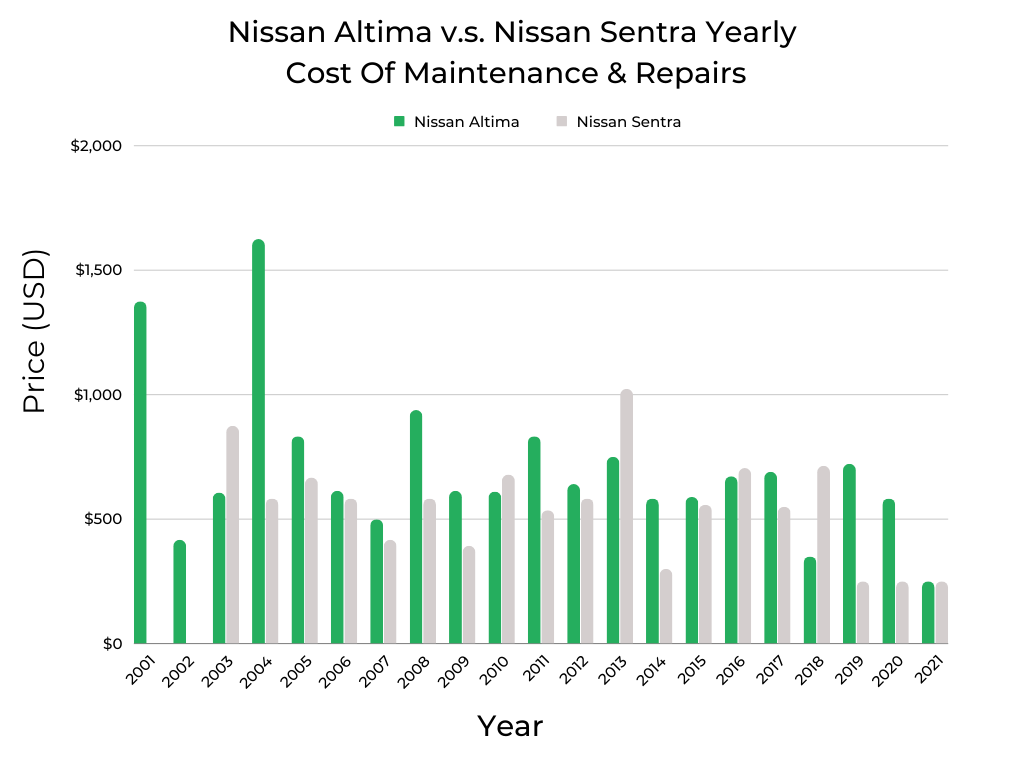
Looking over the Yearly Cost of Maintenance & Repairs chart above gives us a way to see how much an Altima or Sentra costs to keep on the road each year according to owner-reported figures. Aside from a handful of outliers, most model years stay well under $1,000.
However, between 2001 and 2021, the Nissan Altima averages $705 in annual service bills, while the Sentra comes in quite a bit lower at $534. That is reflected on the chart by the gray bars (Sentra) tending to be shorter than the green bars (Altima).
As for the spikes displayed by the 2001, 2004, 2008, and 2011 Altima, each one of those gets a thumbs down on our best and worst model years ranking for the Nissan Altima.
Looking over the best & worst Sentra rankings, we can see that the 2003 and 2013 model years are both on the wrong side of it and both also set relatively high bars above. The point here is to avoid those model years as they are both unreliable and expensive to maintain.
On that note, don’t assume that older cars are automatically more expensive to keep on the road due to high mileage. Some owners pay close attention to regular maintenance, which can allow for big mileage to accrue without issue, while others happily run their cars into the ground. So, do your homework on service history before buying.
Safety Rating Comparison | Nissan Altima vs. Nissan Sentra
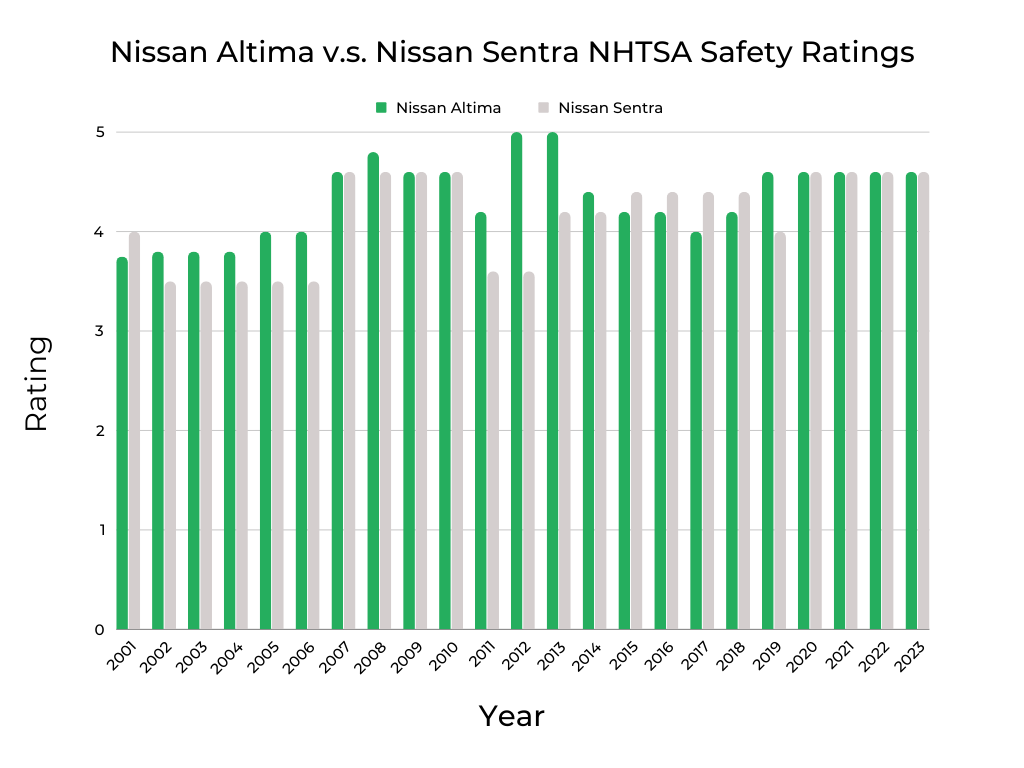
This chart comparing the NHTSA safety ratings of the Nissan Altima and Sentra over the past two decades reveals a pattern of safety that generally improves over time. In particular, for the past 10 years, both Nissans have been at or above a 4 out of 5 for this metric.
In 2011, the NHTSA instituted stricter test protocols that drove an industry-wide decline in safety scores. That is reflected above, however, the Altima rebounded all the way to a 5 out of 5 the following year, while the Sentra remained in the threes.
Otherwise, you can see a trend of steady improvement over the years for both cars that often follows the release of a new generation and with it, upgraded safety systems. 2007 marked the start of a new generation for the Altima and Sentra, both of which posted better scores that year.
The same is true of the 2019 Altima and 2020 Sentra, which were the respective start dates of each car’s latest generation. For more on this safety discussion, be sure to check out our best and worst model years series for the Nissan Altima and Nissan Sentra.
Fuel Efficiency Comparison | Nissan Altima vs. Nissan Sentra
The chart above on the left, which compares average fuel economy for all trim lines of a given model year, is helpful for those who have fuel economy high on the list of car buying priorities as the Sentra mostly exceeds the Altima in this metric.
Though there are a host of factors at play to answer why this is the case, the basics are that the Sentra is a lighter car with a smaller motor, which helps immensely with efficiency. The Sentra’s advantage is most pronounced from 2013 to 2016 and 2020 to 2023.
Of those years, the 2014 to 2016, 2020, and 2021 models are all on the “best of” side of our Sentra model years ranking. One stretch where the Sentra falters is from 2017 to 2019, which coincides with the arrival of the sportier – and thirstier – SR Turbo variants.
All that being said, none of the gas-powered Sentra or Altimas can best the hybrid Altima that was only produced between 2008 and 2011. Looking over our best & worst model years of the Nissan Altima, we can see that only the 2010 model gets a thumbs up, but with an average fuel economy rating of 34 mpg, it’s worth looking at.
Methodology
- Compare two vehicles, Nissan Altima vs. Nissan Sentra, and provide a comprehensive analysis.
- Gather relevant information and data on both vehicles from reliable sources, such as manufacturer specifications, expert reviews, customer feedback, industry reports, and data sources like manufacturer websites, FIXD App, Kelley Blue Book, FuelEconomy.gov, and NHTSA.
- Collect data on various aspects, including performance, safety features, fuel efficiency, maintenance costs, reliability, owner satisfaction, and market value.
- Identify the key criteria that will be used to evaluate and compare the two vehicles.
- Ensure the criteria cover both objective factors (such as performance metrics, safety ratings, and fuel efficiency) and subjective factors (such as owner satisfaction, comfort, and features).
- Assess the performance of both vehicles based on factors such as acceleration, handling, braking, and overall driving experience.
- Compare engine options, horsepower, torque, transmission options, and any unique performance features.
- Examine the safety features and ratings of both vehicles.
- Evaluate crash test ratings, advanced driver assistance systems (ADAS), active and passive safety features, and any notable recalls or known issues related to safety.
- Consider both NHTSA safety ratings and IIHS awards for a comprehensive safety assessment.
- Analyze the fuel economy of both vehicles based on EPA mileage estimates.
- Compare their MPG ratings, average full-tank range, and any significant differences in fuel efficiency.
- Assess the average annual maintenance and repair costs for both vehicles.
- Consider data from surveyed owners and other reliable sources, such as FIXD App owner surveys, to determine the overall cost of ownership over time.
- Evaluate the reliability of both vehicles based on owner reports, FIXD App data, and any known issues or recalls.
- Consider factors such as engine reliability, common problems by model year, long-term durability, and owner reliability scores gathered from surveys.
- Consider owner satisfaction by gathering information from forums, online communities (Reddit: r/whatcarshouldIbuy), customer reviews, and owner reliability scores.
- Summarize key factors that owners appreciate and any common complaints or drawbacks mentioned by owners.
- Compare the features and technologies offered by both vehicles.
- Highlight any notable differences in terms of infotainment systems, connectivity options, driver assistance features, interior quality, and available upgrades.
- Assess the market value and depreciation of both vehicles.
- Compare average prices, resale value, and how the vehicles hold their value over time.
- Consider average private-seller valuations from Kelley Blue Book (KBB) for a comprehensive assessment.
- Summarize the findings of the comparison, highlighting the positives and negatives of each vehicle.
- Provide a fair and balanced recommendation based on the comparison, considering factors such as budget, personal preferences, specific needs of the buyer, and the comprehensive analysis conducted.
Sources:
- KBB Values: Average private-seller valuations as supplied by Kelley Blue Book (KBB), based on a Nissan Altima and Nissan Sentra with typical mileage for that respective model year.
- Fuel Economy: Mileage-per-gallon estimates according to the EPA MPG on Fueleconomy.gov.
- Annual Maintenance/Repairs: Upkeep expenses as reported by surveyed Nissan Altima and Nissan Sentra owners.
- Safety Ratings: Crash test data collected and reported by NHTSA. We average all ratings for each year to come up with a simplified, average safety score. This makes it easier to look at on a graph. We also collected IIHS Awards for this article.
- Vehicle Features: Most or all information gathered on vehicle features were from the manufacturer websites, in this case NissanUSA.com

Niel Stender grew up doing replacement work on his old Cherokee and sweet Mitsubishi Starion, which led to a degree in mechanical engineering and a job at Ford as a vehicle dynamics engineer. His writing infuses that automotive background with sales and marketing experience. Writing about cars for close to a decade now, he enjoys digging into some of the more technical mechanical systems under the hood and throughout a vehicle.

